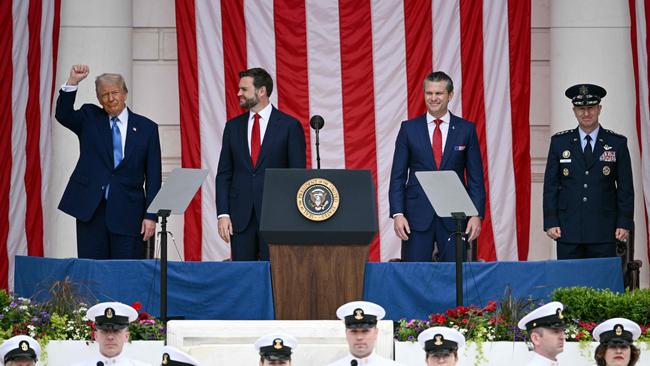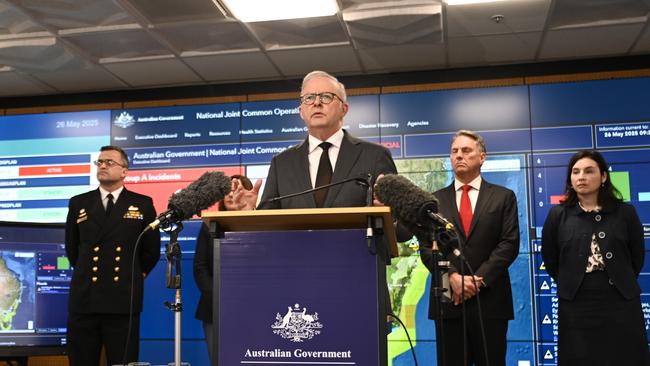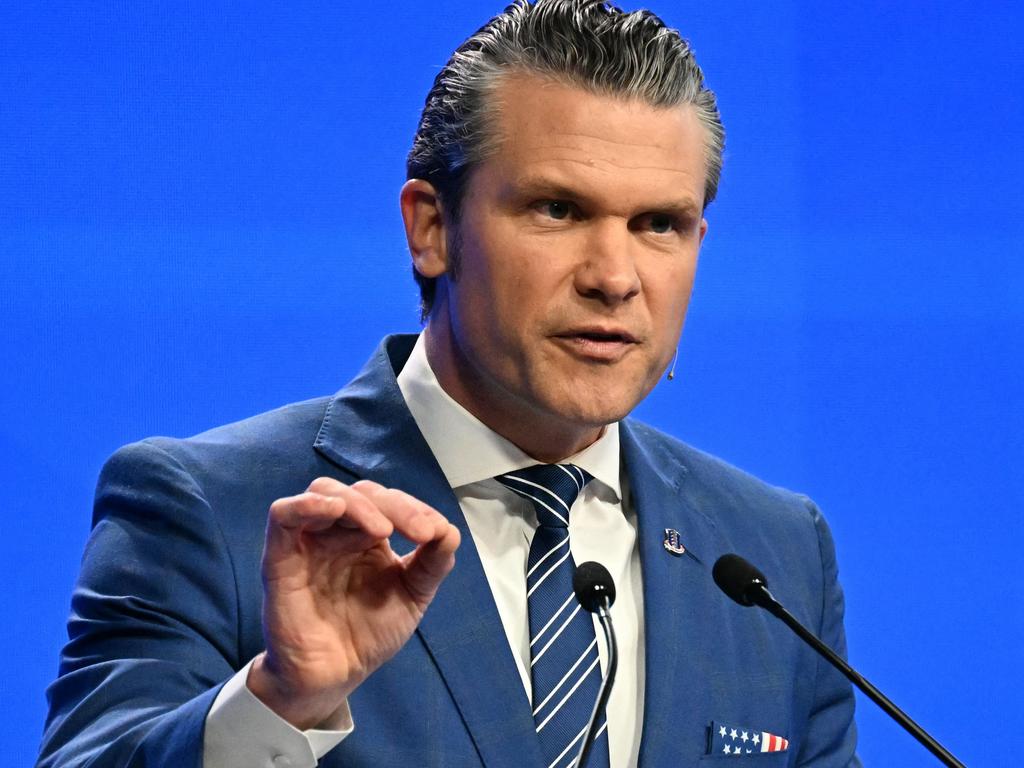PM likely to avoid White House because of shame of our defence failure
In defence, we are the Mr Magoo nation, continuing on our way sublimely indifferent to the circumstances around us.

The Trump administration, through Defence Secretary Pete Hegseth, in a conversation in Singapore last weekend, demanded Australia lift its defence spending from the pathetic 2 per cent of GDP, where it is now, to 3.5 per cent. This was, Hegseth said, because of the threat posed by China’s military build-up and its intention, perhaps imminently, to take military action against Taiwan. Beijing denounced Hegseth but also Australia’s Richard Marles, more or less for nodding in polite agreement.
Last Sunday, Ukraine destroyed billions of dollars of Russian warplanes, including strategic bombers, with cheap drones smuggled into Russia. Australia has only one armed drone and no significant counter-drone capacity. (Australia does spend billions of dollars on projects like Ghost Bat, an unarmed surveillance plane without a pilot, but has none of the cheap, lethal drones that Ukraine used against Russia.) Chief of the Defence Force Admiral David Johnston declared this week that for the first time since it was attacked by Japan in World War II, Australia might have to wage war from its homeland. The implication of Johnston’s revolutionary comments is that there is now a potential adversary that, with missiles, could hit any part of Australia. And that Australia needs to be able to defend itself.
Keir Starmer’s British Labour government brought down its strategic defence review this week. Starmer has already committed to lifting defence from today’s 2.3 per cent of GDP to 2.5 per cent in less than two years, 3 per cent in the next parliamentary term with the intention of reaching 3.5 per cent. Germany is committed to 3.5 per cent on defence and another 1.5 per cent on defence infrastructure. Britain plans a bigger army, more reservists, increasing nuclear attack subs from seven to 12 and spending £15bn ($31bn) modernising its nuclear warheads, which are launched from its separate nuclear missile submarines.
In words that apply equally to Australia, Britain’s review commented: “The West’s long-held military advantage is being eroded as other countries modernise and expand their armed forces at speed, while the United States’ security priorities are changing.” The future will involve “multiple and concurrent dilemmas, proliferating and disruptive technologies, and the erosion of international agreements”.
The British will spend billions of pounds on drones and counter-drone capabilities. Like the American military, the British will integrate drones and counter-drone capabilities into mainstream military doctrine.
Through all these crushing waves of military threat and turmoil, the Albanese government smiled vacantly. What do you think of all this, the Prime Minister was repeatedly asked. His response, metaphorically, channelled Peter Sellers playing Chauncey Gardner, the most unlikely man ever to be president, whose pathological passivity was mistaken for shrewdness: I like to watch.
In defence, we are the Mr Magoo nation, continuing on our way sublimely indifferent to the circumstances around us.
Everyone who gives the matter thought tells the Albanese government it cannot defend Australia, it certainly can’t acquire nuclear subs as well, with 2 per cent of GDP. We have a modernised version of exactly the same defence force we had in the 1980s – 100 fast jets, six submarines, six battalions, a surface fleet of 10 or 12. Except most of our force now, apart from our air force, is old and decrepit.
Hegseth in his keynote speech in Singapore noted the biggest Europeans are moving to 5 per cent of GDP for defence. Apart from Germany, Britain and Poland, that’s a bit of an exaggeration. But virtually all the Europeans are significantly increasing defence spending. Marles himself said China is engaging in the greatest military build-up since World War II, without transparency or reassurance. Hegseth’s question is unanswerable: in the face of this, how can Australia stay so puny?
The Australian defence budget has bounced around 2 per cent of GDP for a decade. In 2017-18 it was just under 2 per cent, in 2021-22 it was just over, this year it’s just over again. Yet Albanese government ministers fatuously proclaim they’ve undertaken the biggest defence funding increase in peacetime.
They make this highly misleading claim through two sleights of hand. First, the high inflation their spending caused meant every area of government spending went up in nominal dollars. The other sleight of hand is to give themselves credit for spending increases that they’ve only promised for the future.
Thus Albanese, Marles and Defence Industry Minister Pat Conroy boast they’ve committed $50bn extra to defence. But this doesn’t start to appear significantly until 2028-29. That’s in the third Albanese government – a dismal lack of urgency.
Financially, defence has been a low priority for the Albanese government. In the coming financial year, Australia will have a staggering $777bn in federal government expenditure. Defence spending is about $55bn. If we moved from 2 per cent GDP to 2.5 per cent, this would require $13.5bn additional expenditure. Instead the Albanese government plans to reach just 2.3 per cent of GDP by 2033.

The Trump administration, in contrast, puts its money where its mouth is. The US plans a 13 per cent increase in defence spending to $US1 trillion ($1.5 trillion). Every American makes a contribution to allied security well over twice the contribution we make. Our defence budget translates to $US36bn.
The US population of 350 million is about 12½ times our population of 28 million. If they made the same contribution we do, their defence budget would be about $440bn, just over 40 per cent of its current level. The US couldn’t then provide the vast intelligence and logistics support, plus physical security, plus extended nuclear deterrence, that it supplies to Australia right now.
Few Australians appreciate how comprehensively we rely on the US. Ed Husic, when industry minister, in a typical act of farsighted genius, abolished the program under which we were going to launch, own and operate low Earth orbit satellites. That of course would just have been the beginning of our satellite journey.
Low Earth satellites have lots of limitations. But as it stands, we’re entirely reliant on US satellites. Without the alliance, we couldn’t even fire those very few sophisticated weapons we have because we couldn’t locate the targets.
The disproportionate US contribution goes far beyond this. The US spends many billions of dollars on its nuclear weapons beyond the defence budget, in the Energy Department. These weapons allow it to impose some constraints on the behaviour of Russia, China and others.
It’s actually much worse than it seems. The Australian military is in crisis. With 59,000 full-time ADF members, about half a Taylor Swift concert, we’re 6000 short of where we should be even under our present unbelievably modest plans. Joining the ADF is still an epic bureaucratic obstacle course that initially interested smart young people routinely drift away from.
Nothing in Australian defence happens in realistic, useful or meaningful timeframes. Every capability undergoes death by delay. The Ukraine war has been going for more than three years. It has revolutionised techniques of warfare and underlined that we live in the age of missiles and of drones.
Critics have been telling the ADF this for years. But still we have only one armed, lethal drone actually established in the ADF. We have Australian companies that make drones for Ukraine but they don’t make sales to the ADF.
The Ukrainian drone strike was a devastating proof of the strategic power of cheap drones. They embody a contemporary philosophy of arms – the cheap, the many and the swarming defeat the big and the cumbersome.
Our defence force is addicted to buying tiny numbers of exquisitely complicated platforms, often endlessly redesigned for Australia’s allegedly unique conditions, completely ignoring the small, the cheap and the many.
The Houthis taught us a similar lesson to the Ukrainians about drones attacking ships in the Red Sea. Yet Australia has neither armed drones nor any serious counter-drone capabilities.
Retired major general Mick Ryan tells Inquirer: “We’ve got a crisis on our hands. You talk to people in the Australian Army, they never see drones. You talk to Ukrainians, they see drones all the time.”
Ryan’s point is that, partly for budgetary reasons, partly because of a top-heavy, woefully process obsessed and above all slow bureaucratic culture, the ADF is almost entirely missing the dominant form of today’s conventional warfare.
That drone and counter-drone technology can change quickly is no bar to a regular military using them extensively. Go into contract with an Australian company, buy as many drones as the ADF can use, then use them all up in training. Train too in counter-drone technology and keep buying new drones to replace the old as the technology shifts.
Drones are so cheap, you could buy, use, cannibalise, restock etc all for less than the salary costs of starred officers working on AUKUS.
We also have almost no ground-based missile defence systems. Our northern air bases, our air force squadrons, much of our naval assets could be destroyed on the first day of conflict, especially if we weren’t given notice, by conventional missiles.
Admittedly drones would be cheaper. Getting drones within range of the target is simple. Sail a ship into harbour with a container full of drones. Send a few agents into Australia to hire trucks and drive drones near our bases. Launch drones at our coastal bases from nearby ships. Carry swarms of drones in a big plane’s cargo bay. Design drones that travel a long distance. So long as they’re cheap, get to their target and go bang in the night.
The Albanese government isn’t doing any aspect of its job in defence. The Defence Strategic Review called for layered missile defence programs to protect military and other key assets. The National Defence Strategy of 2024 abolished most of our ground-based missile defence programs.
When the Albanese government came to office the nation had eight aged Anzac-class frigates and three air warfare destroyers. The government decided not to do the scheduled military upgrade on Anzacs, though it has improved some of their weapons.
One of the Anzacs had to be retired. It’s widely rumoured another will soon be kaput. Even without that, our surface fleet consists of 10 ships – seven tiny, decrepit, radically undergunned Anzacs and three AWDs. It’s the oldest surface fleet we’ve had, and one of the smallest.
Our six aged Collins-class subs are in desperate trouble. It transpires we can’t do the full life-of-type extension we planned to get another 10 years life out of them.
Former Defence Department deputy secretary Peter Jennings thinks LOTE is now so expensive, and so uncertain of success, that we should approach the Japanese to sell us their Taigei-class conventional submarines as the interim capacity we’ll need. We could get four or six. Otherwise, Jennings argues, there’s every chance of a prolonged period with no subs.
This is a smart idea but wildly too radical for Australia. The smart way to do it would be to get the subs built in Japan with no alterations at all. Just use Japanese combat systems, torpedoes etc. We can operate these alongside our nuclear subs when and if they ever arrive.
But we never do a smart thing in defence, ever. Conroy, decrying the nay-sayers, was boasting that we’ve bought Tomahawk missiles, which give us long-range strike. But we once planned to put Tomahawks on the Collins, then we changed our minds. Now the Tomahawks will go only on the three AWDs. The AWDs only have 48 vertical launch cells each. You need a lot for self-defence. The navy’s rule of three means that of three AWDs, when everything is going well, we’d expect to have one on operations.
So all the Albanese government’s bluster about buying Tomahawk missiles – and it’s not clear we actually possess any stocks yet – comes down to one ship being armed with a handful of Tomahawks sometimes. When you have a pathetically tiny navy – effectively three modestly sized AWDs – you can’t be formidable.
Just addressing drones, counter-drones, missile and air defence, and offensive missiles, this would more than absorb an increase in the defence budget from 2 per cent to 2.5 per cent of GDP.
The government is still taking forever to decide whether to buy a Japanese or German general purpose, very small frigate. Like everything, it’s insanely slow. The choice should be obvious. The Japanese is the more powerful ship and Japan the nation with which we have a more important strategic relationship. But anything would be better than nothing.
One reason Hegseth spoke with such urgency about our need to do more is that, along with every other serious analyst, he believes a Chinese military move against Taiwan a strong possibility.
If that happens and America doesn’t come to Taiwan’s aid, probably the whole US alliance system in Asia collapses. Japan and South Korea could well acquire their own nuclear weapons. China would dominate our region. If America ever fully retreated to its own hemisphere Australia would be isolated and completely undefended in the most dangerous strategic environment since 1942.

The best way to stop all this is to convince Beijing of the credibility of allied military deterrence. Australia contributes its flag, its territory and almost nothing else. Yet in a US-China military conflict over Taiwan we would almost certainly be attacked, by missiles, drones, cyber and who knows what else.
The Albanese government is perfectly asleep to all this. In World War I we made a heroic contribution to allied victory. In World War II we did our best, which was very good. Since then, we’ve designed the ADF not to provide for Australian security, defend the continent or undertake any strategically significant military task. It has been designed entirely to provide niche contributions to American expeditionary wars, the diplomacy of managing the Americans, to entrap them into providing our security.
The AUKUS subs project can probably be seen in this light. When Scott Morrison announced them he didn’t tell the nation they’d require a huge boost in defence spending. If Albanese had signed on to that, we’d be much better off.
But I’ve come to suspect the AUKUS project is not mainly about acquiring a military capability but, rather, cajoling the Americans into more intimate association with us, basing one or two of their subs here, in effect providing for our security while we do almost nothing.
It’s not the Americans who lead us into foolish wars. It’s we who pretend to do much more than we do, to lure them into providing our security.
Donald Trump seems unlikely to swallow that deal in the way previous presidents have. I guess Albanese will avoid a joint White House press conference with him at almost any cost.






To join the conversation, please log in. Don't have an account? Register
Join the conversation, you are commenting as Logout